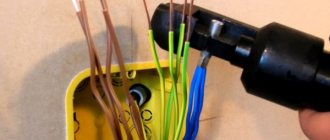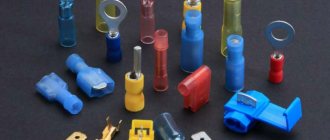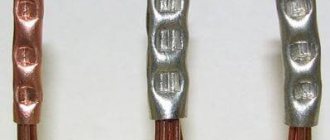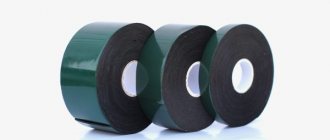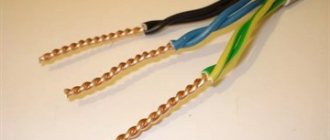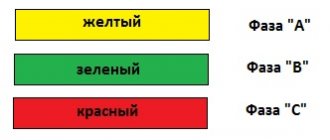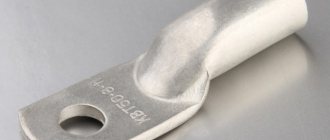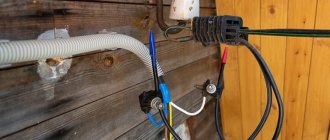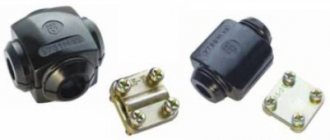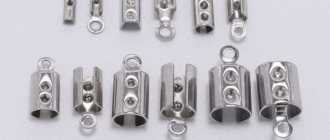Crimping technology
There are two methods by which crimping is carried out:
- local indentation;
- complete compression.
The wire for crimping is copper or aluminum. Therefore, the sleeve can be either copper or aluminum. There is also copper-aluminium. Since an aluminum cable is prone to the formation of an oxidizing film, the aluminum sleeve must be cleanable and treated with a special lubricant. To protect aluminum from oxides, quartz vaseline paste is used. Copper wire is also subject to lubricant treatment. With its help, the likelihood of damage to the core during crimping is reduced and friction is reduced.
If the cores are multi-wire, they are aligned and folded so that they easily fit into the sleeve; you can twist the wires a little. Then the cable is inserted into the cartridge until it stops. The connection can be made not end-to-end, but, for example, with a factory. Then the total cross-section of all wires should not exceed the cross-section of the bushing.
In any case, sleeves are used that are designed for the total cross-section of the cores being crimped. If a press with point (local) indentation is used, make 2-3 pressings evenly distributed along the length of the sleeve to ensure mechanical strength of the connection and good electrical contact. For continuous crimping using hexagonal or square dies, the recommendations are essentially the same
In both cases, it is important that the sleeve does not crack during crimping (if it is too small) and that there are no uncompressed areas or cavities (if it is too large)
After the crimping has been carried out, it is necessary to create an outer insulating layer at the junction using electrical tape or elbow cloth. After insulation, you should carefully fold the wires and the cable itself in the junction box.
The video below clearly shows how to crimp wires with press pliers:
The procedure for crimping tips and sleeves
For crimping thick-walled tips and sleeves, it is best to use a hydraulic press. The press set initially includes universal dies for any tips and wires. Under no circumstances use a tool not intended for crimping (hammer, chisel, etc.). A contact pressed in this way will not last long, especially if it constantly experiences heavy loads.
The next question that arises for an ignorant user is how many times should I press the tip with a press? Once, twice or three times? This depends on 2 parameters:
- ⚡
from tip length - ⚡
and matrix width
In the operating instructions for the press that comes with the tool, there is a plate indicating the required number of crimps. Please note one thing: this table is intended for tips and sleeves made in accordance with GOST. How they differ from other brands can be found in the article Cable lugs, markings and types.
Insert the tip into the press so that the matrix cross-section markings (35-50-70, etc.) are imprinted on the front side of the tip, and not on the side or bottom.
- ⚡
The first crimping of the tip should be done closer to the blade (where the bolt is inserted) - ⚡
Perform the following crimps in order, moving from the blade to the tail of the tip - ⚡
the same rules apply for sleeves
This must be done in this sequence, because with each press the tip tends to lengthen (sometimes up to ten percent!). And if you start pressing from the end (not from the blade), during the last crimp, there is a high probability that you will have a void at the end of the sleeve. And you will not achieve the contact that was necessary.
First of all, this applies to all aluminum products. For copper this is not yet so critical.
When crimping from the side of the blade, the tip will seem to fit onto the core, tightening the connection more and more. The insulated tips even have special digital markings indicating the pressing order.
The crimping ends at the moment when the matrices close together. If you need to perform two or three crimps, step back 2-3mm from the previous crimping point and continue crimping.
When crimping, the formation of a small flash is acceptable. It can be removed or filed off. A very common mistake is the formation of large “ears” on the tip. This results from an incorrect choice of matrix.
If such “ears” do appear, you should not cut them down to the base of the sleeve . Otherwise, a gap may form in the tip and the crimp contact will become loose.
After the tip is crimped, it is advisable to insulate the area between where the shank ends and the remaining uninsulated part of the core. It is best to use heat-shrinkable tubing for this.
How to connect electrical wires with lugs
Another way is to use tips. The tip looks like a piece of tube, cut and turned flat on one side. A hole for a bolt is drilled in the flat part. The lugs allow you to connect cables of any diameter in any combination. If it is necessary to connect a copper cable to an aluminum cable, special lugs are used, in which one part is copper and the other is aluminum. It is also possible to place a washer, brass or tinned copper, between the tips.
The ferrule is pressed onto the cable using a crimper, similar to how wires are connected using crimping.
Security measures
This type of connection requires certain security measures to be taken, among which are the following:
- The metal of the sleeve must be the same as the metal of the conductors;
- You cannot shorten sleeves if they are large from the factory. Many electricians simply saw off parts that they consider unnecessary with a hacksaw, which is not recommended due to the reduced reliability of the contact connection;
- The work must be performed only using special tools. Simple wire cutters or pliers are not suitable for this, as there is a risk of injury and an unreliable connection;
- The choice of sleeve should be based on the following: its internal diameter should be as close as possible to the same as the diameter of the cable being crimped.
Thus, there is nothing difficult in crimping even multi-core cables using cable sleeves. Despite this, it is necessary to observe some nuances: perform crimping only with a special tool and make connections only after a good connection.
How to brew twist
For good contact, the twist can be welded with a graphite electrode or a gas torch. Torch welding has not become widespread due to the complexity and the need to use gas and oxygen cylinders, so this article only talks about electric welding.
Electric welding is performed using a graphite or carbon electrode. Graphite electrode is preferable. It is cheaper and provides better welding quality. Instead of a purchased electrode, you can use a rod from a battery or a brush from an electric motor. It is better not to use copper electrodes. They often get stuck.
For welding, you first need to make a twist 100 mm long, so that the finished one turns out to be about 50. The protruding wires need to be trimmed. For welding, it is best to use an inverter welding machine with adjustable current. If this is not the case, then you can take a regular transformer with a power of at least 600 W and a voltage of 12–24 V.
Near the insulation, “ground” or “minus” is connected using a thick copper clamp. If you simply wrap a wire around a twist, the twist will overheat and melt the insulation.
Before starting welding, it is necessary to select the current. The required current varies depending on the number and thickness of the wire that makes up the twist. The welding duration should be no more than 2 seconds. If necessary, welding can be repeated. If everything was done correctly, then a neat ball will appear at the end of the twist, soldered to all the wires.
Tip sizes, design features
The minimum available sections for GML are 1.5 mm 2. Further sizes increase - 2, 4, 6, 10 mm 2 and higher. Based on these values, we can say that the cross-sections of the sleeves are equal to those of wires and cables. It is quite easy to decipher the tip designations. For example, GML-6 is a copper tip, tinned. The cross-section is 6 mm 2. In the case of combined sleeves, the marking indicates two sizes - for aluminum wire and for copper. For example, GAM 16/10 - 16 for aluminum, and 10 for copper.
By design, the sleeves can be end-to-end in the form of a hollow tube or with a partition. The latter are used when crimping wires with end-to-end lugs is performed. These partitions are located in the middle of the sleeve. With their help you can adjust the depth of the cable entry. If it is necessary to extend it, then both ends will go into the tip to the same length.
Connecting wires with PPE caps
Connecting wires with PPE caps (Connection Insulating Clamps). PPE are plastic caps with a conical spring inside, which, when twisted, compresses and fixes the wires, and the plastic PPE cap itself insulates the connection of the wires and is fire and mechanical protection.
This wire connection is quick and simple; to perform it correctly you need:
- strip the insulation from wires and cables to a length slightly shorter than the length of the PPE cap itself;
- fold them into a bundle, precisely into a bundle, and not twist them;
- use your hands to twist the PPE clockwise onto the bundle of wires;
- tighten the PPE using pliers.
The advantages of such a connection of wires and cables are obvious (no special tools required, no need for additional insulation, speed and simplicity), but there are also disadvantages:
- Do not connect multi-wire wires;
- the quality of such a connection will be worse than those listed above, so I would recommend using these clamps for small loads, for example, in lighting circuits.
PPE caps are divided according to the total cross-section of the wires to be twisted and are designated by numbers from 1 to 5, which indicate the number of wires to be twisted and their cross-section.
Principle of wire crimping
You can perform crimping of wires using sleeves in several ways. It will not be possible to single out the best of them, since comparison is inappropriate here. The choice of crimping method directly depends on the conditions for electrical installation work, cross-sectional parameters and other important points. Let's consider the features of the main method of crimping using sleeves.
Work begins by introducing the previously stripped ends of the wires into the cavity of the sleeve. The next step is crimping - squeezing using a special tool. The metal surface of the cores and sleeve is compressed, resulting in a reliable adhesion of the parts. It is necessary to connect at several points, followed by insulation of the connection points. An exception is working with insulated sleeves for crimping, which do not require additional insulation.
When choosing this method of connecting wires, you need to remember that the contact will not be disconnected in the future. Taking this into account, work will need to be carried out carefully and prudently.
Advantages and disadvantages
Like any type of connection, crimping has its positive and negative sides. When deciding on the type of connection, you should rely on many factors that make it impossible to use one or another method. Among the advantages of crimping:
- High degree of connection reliability. Only welding or soldering is more reliable than this method;
- Manufacturability of the process. The method takes a very short amount of time and does not require its performer to have any special knowledge in electricity, metals, and so on;
- The pressed sleeve does not require any attention and maintenance throughout the entire life of the cable;
- Does not depend on the availability of power and can be performed even in places where electricity has not yet been supplied.
You may be interested in How to extend the antenna cable
Performing crimping
But this connection method has quite a few disadvantages. The main ones are:
- The need to have a special tool with you - press pliers or a crimper. You cannot replace them with ordinary pliers;
- The need to constantly carry with you different sleeves for each type of wire or cable, to distinguish between them;
- High costs for raw materials in the form of metal tubes and tools;
- The connection is cumbersome compared to the same methods of welding and soldering, which can result in a seam equal in diameter to an insulated cable.
Important! The method itself is a disadvantage because it is not removable. If necessary, you cannot take and unscrew the connection, and then screw it back.
Various crimp sleeves
The main points of the process of crimping wires and twists
To do this, you will need to strip the wire from the outer insulation, and then use a mounting knife to remove the inner protective sheath. To make it convenient to twist the wires, I personally collect the bare wires into a bundle and bend the ends.
Then, first twisting the wires by hand, I achieve greater contact through the work of the pliers with which I tighten the twist.
Having bitten off the excess wires with the same tool, I get a good connection 3-5 cm long.
Next, the only thing left to do is put copper sleeves of suitable sizes on the twists and crimp them. Moreover, crimps come in different diameters (6 mm, 8 mm, 10 mm and more). Usually, I use 6 mm products to connect strands of light groups, where the cross-section of the wires is not so large (1.5 sq. mm). For socket groups, sleeves with a diameter of 8 mm or more are taken, since here the wires have a cross-section from 2.5 to 4 sq. mm.
After that, I insulate the connections, put them in the junction box and close the lid so that everything is “feng shui”.
Common mistakes when crimping
Cutting shells
At first glance, they are long. People who do not have the necessary knowledge and experience believe that using the entire cartridge case is wasteful, and cut it into pieces. This leads to a reduction in the length of the section where the conductors are bonded. The result is that the mechanical strength of the contact suffers, since working with pliers becomes inconvenient, and the number of pressure points decreases.
Wrong choice of sleeve diameter
If it is larger than required, then it is unlikely that it will be possible to produce high-quality crimping. The only way out is to bend the tip of the wire and then insert it into the sleeve. But such crimping is only suitable for “copper”, but the strength of the connection becomes lower. Aluminum wire breaks easily, so it is not an option.
With a smaller sleeve diameter, people without experience try to “plant” the ends of the wires into it by sharpening them a little. This is absolutely forbidden to do! Reducing the cross-section in a particular area leads to overheating and destruction of the metal. By the way, this often causes inflammation. It remains to add that the contact strength also decreases.
Crimping with pliers
Press jaws are specially designed for this specific job. Crimping with pliers is fraught with the fact that the conductor is deformed, and quite significant. After all, with this connection method it is impossible to control the clamping force. The consequences of reducing the cross-section of the core are indicated above.
Some craftsmen do crimping exactly this way, while assuring that everything is “acceptable.” But this does not mean that this technique is correct. The author came across such a situation and asked the unfortunate master a question: if he needs to do crimping at home, will he also work with pliers? As expected, there was no clear answer.
Useful tips
- It is not always possible to select a sleeve so that after placing the ends of the conductors in it, there are no voids left. The more free space, the higher the risk of poor contact after crimping it. How to proceed? The easiest way out of the situation is to cut pieces of wire (bare) with a length slightly shorter than that of the sleeve, and “hammer” them into it. Such artificial compaction will significantly improve the quality of crimping.
- If the connection of wires is made to extend the line, then their joint should be located in the center of the sleeve.
- When insulating the joint, the tape (tube) must extend beyond the sleeve cuts by at least 10 mm.
- In the case when at least one of the wires is multi-core, or different numbers of them are spliced on both sides, not metal sleeves are used for crimping, but insulated lugs (NSHVI).
It turns out that there is nothing complicated about crimping with sleeves. The main thing is to choose the right size. If the reader takes into account the recommendations given, then it is quite possible to cope with such work on your own. Good luck!
The essence of the method and advantages
Most experts recommend using crimping as the main and only method of connecting wires.
Crimping for wires is a method of connecting them using special sleeves. Visually they resemble ordinary tubes. The main task is to play the role of a connecting mechanism.
The wire strands that need to be connected are inserted all the way on both sides of the sleeve and crimped with special press pliers. The result is a reliable and durable electrical assembly. The tube needs to be compressed in several places, depending on the cross-section of the switched conductors and the length of the cores. The connected sleeve with the conductors is also subject to deformation. Due to compression, the conductors adhere, which ensures reliable electrical contact. Finally, you must insulate the connection point.
Sleeves for crimping wires
The crimping method is most in demand in the following cases:
- if necessary, connect wires with a large cross-sectional area;
- for connecting multi-core conductors;
- if there is a need to connect wires in power lines with a high current load.
- The tool designed for crimping sleeves is used without electricity. In rooms where there is no voltage, crimping is the only connection method.
- Such a connection does not require maintenance throughout its entire operational life.
- Using sleeves, you can connect conductors made of different metals. One of the most common problems faced by electrical installers is connecting copper and aluminum conductors.
- The quality of the connection is at a high level, the amount of time spent is minimal.
- A special crimping tool allows you to connect wires even in very limited spaces, for example, in a box or electrical outlet.
Connection Features
The technology involves two options for crimping. This is a method of local indentation and continuous compression. Copper or aluminum wires are used for work. The sleeve must also be made of these materials. There are also elements made of copper-aluminum alloy.
Since aluminum cables are prone to the appearance of oxidative films on them, the sleeve must first be cleaned and treated with special lubricants. Copper wires are also pre-treated. The use of lubricants in the process reduces the risk of possible damage to the cores. The friction force is also noticeably reduced. Pressure testing is carried out using manual or hydraulic tools. In the latter case - with a figure press. It is usually used in large industries.
How it works? The two ends of the cable are crimped until they take a round shape. Next, the core is inserted into the sleeve until it stops. It is possible to connect not exactly end-to-end. But in this case, the cross-section of all cores does not exceed the bushing. In the case of local compression, contact directly depends on the depth of the pits. The latter can be measured with a caliper. If continuous compression is used, then check the cross-sectional area. Then, when the crimping of the wires is completed successfully, it is necessary to treat the outer layer with electrical tape or elbow cloth. Next, the wire and cable are carefully laid in the junction box.
Materials
To perform the work, you will need not only the availability of materials in the form of sleeves, but also manual or mechanical (hydraulic) press tongs. Samples from the market are capable of crimping a sleeve with conductors with a cross-section of up to 120 millimeters square. For large cables, a hydraulically operated press is provided and driven by a suitable drive.
There are also special pliers with a matrix, which is designed to regulate the punches. This is convenient in the sense that you do not need to adjust the pliers to any size: just insert the conductor and the matrix itself will move into the desired position.
Welding - an alternative to crimping
Important! If you have to work with aluminum wires, you will need a special vaseline-quartz paste that removes the oxide film from the veins and prevents its reappearance.
You may be interested in this Features of the branch clamp
Copper conductors do not need such treatment and, to reduce friction, it is better to lubricate them with simple Vaseline. The thing is that during pressing and deformation, the veins can be damaged, and lubricants that conduct current can minimize the risk of damage.
Alternatives to crimping
Types of connecting tubes
Crimping of wires can be carried out using connecting sleeves in several designs. The choice of connecting tube will depend on the electrochemical properties of the metal from which it is made and its interaction with the material of the wire.
There are several options for materials for the manufacture of sleeves:
- copper;
- tinned;
- combined universal;
- isolated.
Copper tubes (CM) are used for copper wires, the crimping of which cannot damage the protective layer due to its absence. The tubes cannot be used in aggressive environments.
Tinned sleeves (GML) are suitable for copper type cables used in aggressive conditions. The white protective layer covering the surface of the product fully copes with the main functions. The tubes are not suitable for working with aluminum wires due to possible contact of the protective layer, which is partially destroyed during compression, with aluminum.
Combined wire sleeves have a distinctive feature - their shape. The aluminum part is larger than the copper part. This is due to the resistance of aluminum, which exceeds the resistance of copper. During the crimping process using such tubes, wires are inserted on each side, taking into account the type of metal.
The last option for sleeves is insulated (GSI). They replace additional insulation with PVC tapes due to the presence of heat-shrinkable tubing. Their structure is similar to the structure of GML tubes, with the exception of a PVC layer that does not transmit electricity. The protective layer is quite plastic and reliable, indestructible even during the crimping process, taking the shape of a metal.
Basic mistakes: how not to do crimping
During the crimping process the following mistakes can be made:
- Cutting the sleeve when the tube length is too long. This will reduce the contact strength.
- Kinked aluminum wires. This cannot be done, because the metal will break.
- Installing a liner of the wrong diameter. If it is large, then it can only be installed on copper wiring, the wires of which need to be bent.
- Reducing the cross-section of the cores. In this case, the resistance will increase and the coupling area will become very hot.
- Selecting the wrong crimping tool. It is better to use special pliers that will not damage the protective layer.
- Excessive or insufficient number of crimps.
- Use of a press matrix of a different diameter.
To avoid mistakes, you need to use standard sleeve size tables and profile tools.
What is the essence of the method?
Crimping is a method of connecting wires using special sleeves. Outwardly, they look like ordinary tubes and serve as a connecting mechanism.
The wire strands that are to be connected are inserted into the tube from two opposite ends, crimped with press pliers, and as a result, a strong and reliable electrical unit is obtained. The tube is compressed in two or three places, depending on its length and the cross-section of the switched conductors. The connected cores and the sleeve are jointly subjected to deformation. At this moment, the tube compresses and squeezes the conductive surfaces of the conductors. Due to this, the wires interlock with each other, which provides reliable electrical contact.
The junction is then isolated.
Most often, this method is used in situations where it is not possible to use another type of connection. For example, welding requires the presence of electricity so that the welding machine can be connected. When working in a small junction box, it is inconvenient to position the bolt connection, nut clamp or terminal block. And reaching up to the distribution box from the ceiling with a soldering iron is also not very convenient. It is in such cases that crimping wires using sleeves helps out.
The crimping method is most in demand:
- if it is necessary to connect wires in power lines with a high current load;
- for switching multi-core conductors;
- if it is necessary to connect large cross-section wires.
This is interesting: How to choose a cable channel for electrical wiring: let's look carefully
Types of sleeves
It is very important to choose the right sleeves for crimping wires.
According to the material of execution
A copper cable or wire should be crimped with copper sleeves accordingly. They come in two types and have the following abbreviation:
- GM - copper sleeves. They are made purely of copper, do not have any coating or processing, and in appearance they look like ordinary pieces of copper pipes.
- GML – tinned copper sleeves. They undergo a tinning procedure, that is, their surface is treated with a special tin-bismuth layer. This is done in order to prevent oxidation and corrosion processes. It is also known from school physics lessons that copper, like any other metal, oxidizes. Tinning prevents this process; the crimped wires will not enter into a chemical reaction with the tinned sleeve.
I would like to give one useful piece of advice. Do not listen if suddenly one of the experienced electricians tries to prove to you that using GML sleeves it is possible to crimp aluminum wires, since the tin layer will not allow direct contact of aluminum with copper. This is incorrect, because during crimping the surface layer of the tube is deformed and the corrosion process is still inevitable.
To connect aluminum wires, they use products made of the same metal; they are designated GA (aluminum sleeve).
There are also combined sleeves, they are designated GAM (aluminum-copper sleeve), in everyday life many call them aluminum-copper. This option is used when you need to connect wires made of different metals end to end. The sleeve is a tube of two parts; at the junction of dissimilar metals, the connection is made by friction welding. Here everything is extremely simple and clear - you need to insert copper wires into the part of the tube made of copper, and an aluminum conductor into the aluminum part.
And the most modern version with the designation GSI (insulated connecting sleeves). They are based on ordinary tinned tubes, only they are covered with polyvinyl chloride insulation on top. They crimp copper wires. During crimping, the insulating layer is not removed, pliers are put on top of it, and compression is performed. Such sleeves greatly simplify the work of an electrician, since the crimped electrical assembly no longer requires any additional measures to insulate it.
Twist connection
The easiest way to connect wires is twisting. Previously, this was the most common method, especially when wiring in a residential building. Now, according to the PUE, connecting wires in this way is prohibited. The twist must be soldered, welded or crimped. However, these methods of connecting wires begin with twisting.
In order to perform high-quality twisting, the connected wires must be cleared of insulation to the required length. It ranges from 5 mm when connecting wires for headphones to 50 mm if it is necessary to connect wires with a cross-section of 2.5 mm². Thicker wires are usually not twisted together due to their high rigidity.
The wires are stripped with a sharp knife, insulation stripping pliers (ISR) or, after heating with a soldering iron or lighter, the insulation is easily removed with pliers or side cutters. For better contact, bare areas are cleaned with sandpaper. If the twist is supposed to be soldered, then it is better to tin the wires. Wires are tinned only with rosin and similar fluxes. This cannot be done with acid - it corrodes the wire and it begins to break at the soldering site. Even washing the soldering area in a soda solution doesn’t help. Acid vapors penetrate under the insulation and destroy the metal.
The stripped ends are folded parallel into one bundle. The ends are aligned together, the isolated part is held firmly with your hand, and the entire bundle is twisted with pliers. After this, the twist is soldered or welded.
If there is a need to connect the wires to increase the total length, then they are folded opposite each other. The cleaned areas are placed crosswise on top of each other, twisted together by hand and tightened tightly with two pliers.
You can only twist wire made of the same metal (copper with copper, and aluminum with aluminum) and of the same cross-section. Twisting wires of different sections will turn out uneven and will not provide good contact and mechanical strength. Even if it is soldered or crimped, these types of wire connections will not ensure good contact.
Standard crimping errors
There are several typical mistakes that novice electricians or those who carry out the core crimping process themselves make. For example:
- The used sleeve has a cross-section smaller than the wire. There is never any need to reduce the cross-section of the cores and adjust it to the diameter of the sleeve. This leads to an increase in resistance and a decrease in throughput. Where there was a combination, the vein will heat up and collapse.
- Large size sleeve. If the socket is used with a large diameter, it will not bring a strong and reliable connection. Even if you bend the wire several times, this will not lead to good performance, since the mechanical strength will drop by almost half.
- Cutting the sleeve into several parts. When crimping a cable with a short length of exposed ends, it is inconvenient to work with pliers, and the contact area is reduced.
- Crimping should be carried out exclusively using press jaws. Special tools were invented for this joining method. Therefore, you should not use pliers or a hammer, as this can damage both the sleeve and the cable. To prevent this from happening, it is necessary to use a tool such as press pliers, as they greatly simplify the work of crimping cable connections.
That's all I wanted to tell you about how wires are crimped with sleeves. We hope the information provided was useful and interesting for you!
You probably don't know:
- Methods for connecting LED strip
- Which electrical tape is best for electrical wiring?
- How to find a junction box in a wall
Connecting wires and cables with sleeves
10/12/2016 1 comment 4
There are many ways to connect electrical cables. which have their own advantages and disadvantages. They can not only be combined by welding or soldering, but also twisted, secured in terminal blocks, and secured with PPE. One of the most reliable and optimal connections is crimping wires with sleeves. Thanks to this method, good electrical contact and high mechanical strength can be obtained. Crimping is a permanent connection and after it the wire cannot be disconnected, it can only be cut. It is done as follows: the sleeve and the cores that are inserted into it are deformed under the action of the press and a reliable electrical contact is formed that satisfies the rules of the Electrical Code.
Wire crimping: common mistakes
Many novice electricians or people who do not have information in the field of electrical installation often make a number of mistakes that affect the subsequent operation of the entire electrical circuit.
Pressure testing can be carried out using sleeves or tips
Installation errors:
- The sleeve cross-section is smaller than the cable cross-section;
- Sleeve of larger cross-section;
- Saving;
- Crimping without using pliers.
When purchasing crimps (sleeves), many do not take into account such an important factor as the cable cross-section. Therefore, after purchasing a crimp sleeve or sleeves, it turns out that its cross-section is smaller than the cross-section of the wire.
The main mistake that is made in this case is reducing the cross-sectional area of the cable, which is completely unacceptable. This is due to the fact that at the junction of the wires, resistance increases, which leads to heating of the wires during operation. And if a device with higher power is connected to this network, the wire may simply burn out and lead to a short circuit.
The use of sleeves with a large cross-section will not allow achieving high-quality and reliable contact
It is important to understand that with this connection, the mechanical strength also decreases
In order to save on connecting elements, many divide one sleeve into several parts, thereby increasing the resistance accordingly.
The rules stipulate that crimping of sleeves must be done only with a special tool in the form of press pliers. Therefore, a hammer or pliers are completely unsuitable for this job.
This is due to the fact that using a hammer can damage the sleeve, and compressing the sleeve with pliers is not enough for good contact.
Differences in wire crimping tubes by material
Connecting sleeves are divided into several types depending on the material of manufacture. The use of different types is due to the fact that, due to the electrochemical properties of metals, some react actively with each other, which leads to oxidation of the wires and their overheating under load.
Copper sleeves
The abbreviation GM indicates that the sleeve is made of high-quality copper. Used exclusively for connecting copper wiring. The surface of the GM is not covered with a protective shell, so it can only be used in non-aggressive environmental conditions.
Tinned sleeves
Tinned sleeves are used to connect copper wires intended for use in aggressive environments. These are the same copper sleeves, only their surface is coated with a special compound that forms a white protective shell. The abbreviation is as follows - GML.
The advantage of tinning is to protect the material from electrochemical corrosion, however, it is prohibited to use GML for aluminum wiring. This is due to the fact that during the compression process the protective layer is partially destroyed, which will result in direct contact between aluminum and copper.
Connecting tubes for cores made of different materials
The installation of electrical lines, as a rule, is not complete without the use and connection of cores made of different materials. For such purposes, special sleeves are used, which are considered combined and are called GAM. The design is simple, but its peculiarity lies in the use of different materials. Two parts of the tube are welded into one, one is made of aluminum and the other of copper. The middle, the junction is equipped with a special limiter. Thanks to it, equal input of the cores is ensured on both sides.
This variety differs in shape. This can be explained by the fact that the aluminum part of the tube has a larger diameter due to the need for a larger cross-section of the conductor.
The algorithm for crimping GAM is similar to the previous methods.
There is another type of sleeves designed for crimping wires. Its difference lies in the coating of the surface with insulation. Their operation does not require the additional use of connecting heat-shrinkable tubes or PVC tape. The surface of the sleeves is covered with a material that has plastic characteristics. During crimping, the PVC layer is also compressed, but there will be no direct contact between the sleeve and the wire.
Classification by material of manufacture
One of the main parameters, depending on which wire sleeves are divided into different types, is the material of their manufacture. The need to use dissimilar sleeves is determined by differences in the electrochemical properties of the connected wires made of different metals. So, if an inappropriate sleeve is chosen to connect wires made of a certain metal, the place of the formed contact will oxidize, which over time will lead to a decrease in its reliability in terms of electrical conductivity.
The main types of sleeves for crimping electrical wires, depending on the material from which such tubes are made, are:
- copper sleeves;
- tinned connecting sleeves;
- combined;
- isolated.
Copper
A copper sleeve, which is marked GM, is needed for crimping wires also made of copper. Taking into account the fact that the copper sleeve does not have a protective coating, it can only be used to connect wires operated in a non-aggressive environment. If you neglect this requirement, the copper sleeve will quickly oxidize and cease to perform its functions.
Copper cable sleeves must be made from copper tubes of grades M1 or M2
Tinned
To connect electrical wires operated in an aggressive environment, tinned copper sleeves for crimping are used, which are marked GML. In order to protect the main material of their manufacture - copper - from electrochemical corrosion, GML sleeves are coated with a special compound.
This is explained by the fact that part of the protective coating of such a tube is destroyed when it is compressed, which will lead to contact between aluminum and copper and, accordingly, to the development of electrochemical corrosion.
Connecting sleeves type GML, made of electrical copper with a tin-bismuth protective coating
Combined
Quite often, when installing electrical networks, it becomes necessary to connect wires whose cores are made of different metals. To solve such problems, combined type sleeves have been specially developed and are successfully used. The design feature of such crimp tubes, which are marked GAM, is that one half of them is an aluminum connecting sleeve, and the second is made of copper. At the junction of two such tubes, which are connected to each other by welding, there is a special limiter. It is necessary in order to prevent contact of two dissimilar wires inside the sleeve itself.
Adapter cable sleeve aluminum-copper 16/10 sq. mm
Another design feature of combined crimp tubes is that the part of them, which is the aluminum connecting sleeve, has a larger diameter than the tube intended for copper cables. This design feature is explained by the fact that aluminum, when compared with copper, has greater electrical resistance, therefore the wire made from it, which will be connected to the same electrical network with a copper conductor, must have a larger diameter.
The crimping itself using combined sleeve clamps is performed according to the same algorithm as the procedure with sleeves of any other type. However, it is necessary to carefully ensure that dissimilar wires are inserted into a tube of the appropriate metal.
Isolated
Among the crimping tubes used for crimping electrical wires, the category of insulated connecting sleeves is distinguished. The use of the latter eliminates the need to perform additional insulation of the contact area formed with their help. In terms of their design, insulated sleeves are the same tinned copper tubes, the outer surface of which is covered with an insulating layer of fairly durable and at the same time plastic PVC. Due to the mechanical properties of such a protective layer, sleeves of this type can be successfully crimped without compromising their original characteristics.
Fully insulated connection sleeves
Insulated sleeves for hermetically sealed connection of SIP wire cores
Crimping tools
In any hardware store, the electrical goods department offers a large assortment of sleeves. A crimping device is also purchased to complete the task. The most budget and popular:
- Double-jaw equipment has the appearance of pliers, but is additionally equipped with a compression reinforcement with two jaws. There are also different types of crimping jaws, such as round tips or fork jaws. The average cost on the Russian market is 800 – 1000 rubles.
- An analogue of the previous device is four-jaw crimpers. They are intended exclusively for sleeves. The cost is several times higher and already starts from 2000 rubles.
- Wire stripping device. There are several types and modifications depending on the material from which the wiring is made.
A cutter can also be useful for making precise cuts. The price is more than acceptable, about 150 rubles.
How to connect electrical wires by soldering
Connecting electrical wires by soldering is very reliable. You can solder untwisted wires, but such soldering will be fragile due to the fact that the solder is a very soft metal. In addition, it is very difficult to lay two conductors parallel to each other, especially when suspended. And if you solder on some kind of base, the rosin will stick the soldering area to it.
A layer of rosin is applied to the pre-tinned and twisted conductors with a soldering iron. If another flux is used, it is applied in the appropriate manner. The power of the soldering iron is selected based on the cross-section of the wire - from 15 W when soldering headphones to 100 W when soldering twisted wires with a cross-section of 2.5 mm². After applying the flux, tin is applied to the twist with a soldering iron and heated until the solder completely melts and flows into the twist.
After the soldering has cooled, it is insulated with electrical tape or a piece of heat-shrinkable tubing is put on it and heated with a hairdryer, lighter or soldering iron.
When using a lighter or soldering iron, be careful not to overheat the heat shrink.
This method reliably connects wires, but is only suitable for thin wires, no more than 0.5 mm², or flexible ones up to 2.5 mm².
Terminal block connection
A development of the bolted connection is the terminal connection. Terminal blocks come in two types - with a rectangular pressure washer and with a round one. When using a terminal block with a pressure washer, the insulation is removed to a length equal to half the width of the terminal block. The bolt is released, the wire is slipped under the washer and the bolt is clamped again. On one side, you can connect only two wires, preferably of the same cross-section and only flexible or only single-core.
Connecting to a terminal block with a round washer is no different from using a bolted connection.
The connection of the wires is reliable, but cumbersome. When connecting wires with a cross-section of more than 16 mm², the connection is unreliable or the use of lugs is necessary.
How to connect wires by crimping
Another way to connect wires is crimping. This is a method in which a copper or aluminum sleeve is placed on the wires or cables to be connected, and then crimped with a special crimper. For thin sleeves, a manual crimper is used, and for thick ones, a hydraulic one is used. This method can even connect copper and aluminum wires, which is unacceptable with a bolted connection.
To connect using this method, the cable is stripped to a length greater than the length of the sleeve, so that after putting on the sleeve, the wire sticks out 10–15 mm. If thin conductors are connected by crimping, then twisting can be done first. If the cable has a large cross-section, then, on the contrary, in the stripped areas it is necessary to align the wire, fold all the cables together and give them a round shape. Depending on local conditions, the cables can be folded with the ends in one direction or in the opposite direction. This does not affect the reliability of the connection.
A sleeve is tightly placed on the prepared cables or, when laid in opposite directions, the wires are inserted into the sleeve from both sides. If there is still free space in the sleeve, it is filled with pieces of copper or aluminum wire. And if the cables do not fit in the sleeve, then a few wires (5–7%) can be cut off with side cutters. If you do not have a sleeve of the required size, you can take a cable lug by sawing off a flat part from it.
The sleeve is pressed 2–3 times along its length. The crimping points should not be located at the edges of the sleeve. It is necessary to retreat 7–10 mm from them so as not to crush the wire during crimping.
The advantage of this method is that it allows you to connect wires of different sections and from different materials, which is difficult with other connection methods.
What are crimp sleeves?
The accessory is a small metal tube with conductive properties. With its help, you can achieve a permanent connection of wires.
This is the optimal method of fixing cores for medium and high currents. It provides high fusion strength.
Scope of application
Crimping is advisable if:
- It is necessary to connect the wires that are under high load.
- Installation of multi-core or large cross-section cables is required.
- Electrical networks are laid at height, and the conductors are connected inside the distribution box.
This installation method is suitable if visibility is limited where the network is laid.
Various types of sleeves are used for pressing wires.
Types of sleeves
For pressing wires with sleeves, the following types of devices are used:
- GM. Copper element without a protective layer. It looks more like a piece of pipe.
- GML. The surface of the accessory is tinning (electrochemical sputtering). After the procedure, the product becomes resistant to corrosion and does not oxidize. Copper is used to make the tube.
- GA. An aluminum element designed to connect wires made of the same material.
- GAM. Such sleeves are made from several tubes using the friction welding method and are used for crimping copper and aluminum conductors.
- GSI. A special feature of the accessory is the absence of damage to the protective layer during the joining process. No additional manipulations are required. Such sleeves are made from copper.
Advantages and disadvantages of using sleeves
The crimping method has such advantages as high speed and strength of installation and reliability of the resulting contact.
In addition, it differs in that:
- there is no need to use an electrical network: all work is done with hand tools;
- you can connect cores made of different materials into 1 node;
- there is no need to carry out further maintenance;
- no need to have special skills;
- the procedure can be carried out in confined spaces.
The only drawback of the process is that it results in a permanent connection.
To replace the sleeve, you will have to cut it out. If the length of the conductors is reduced, they will need to be extended.
